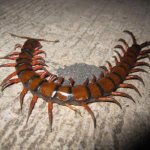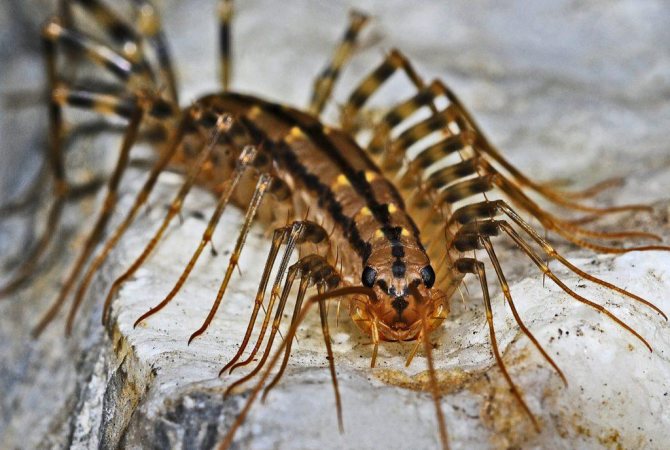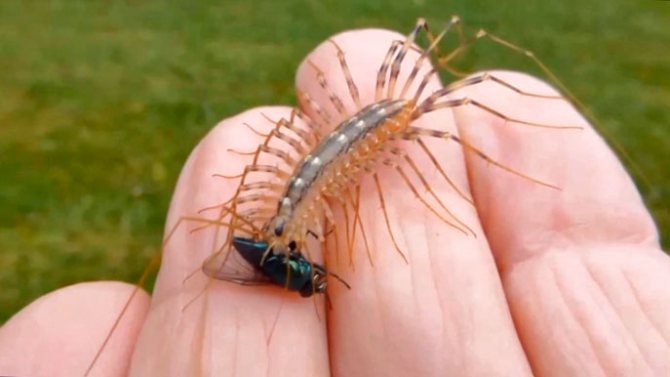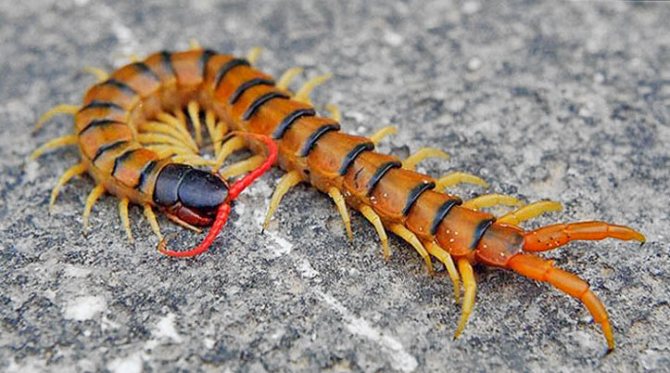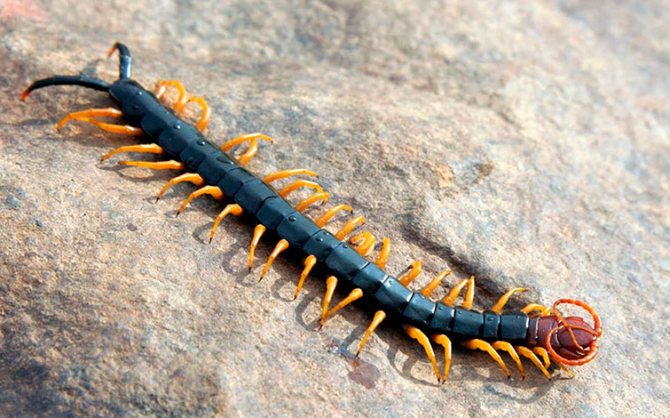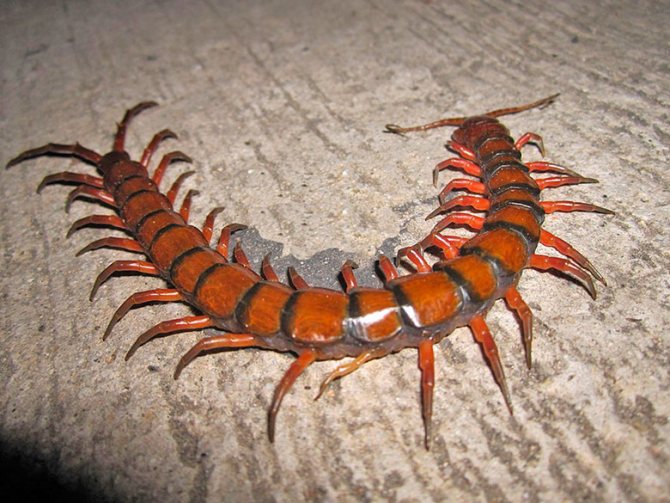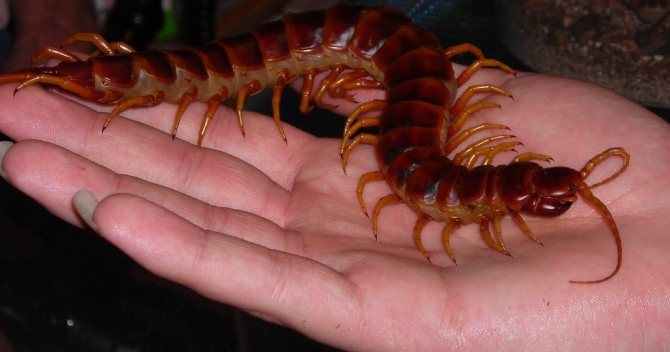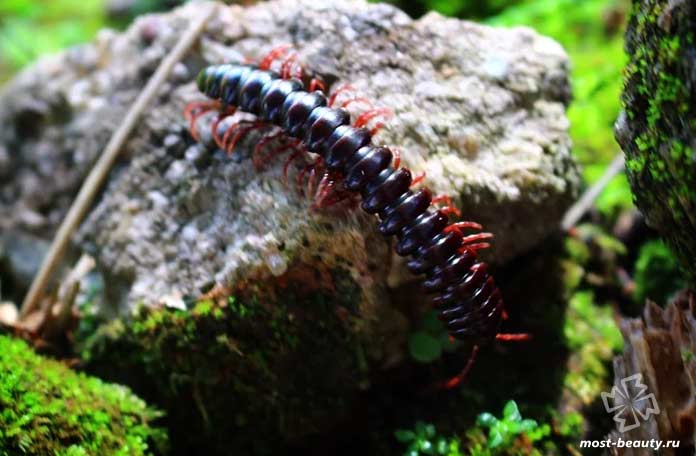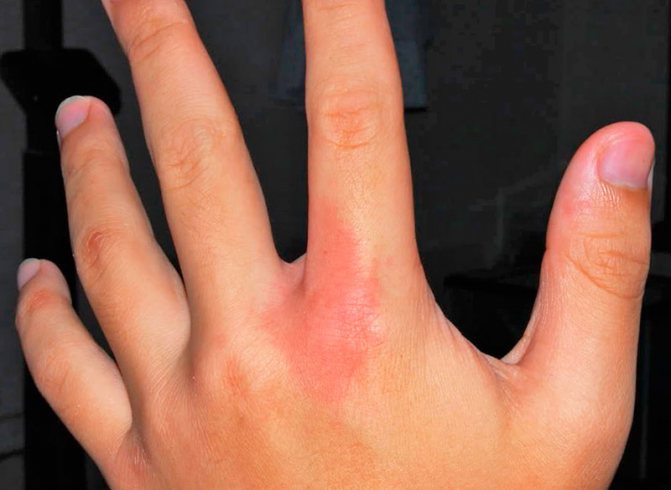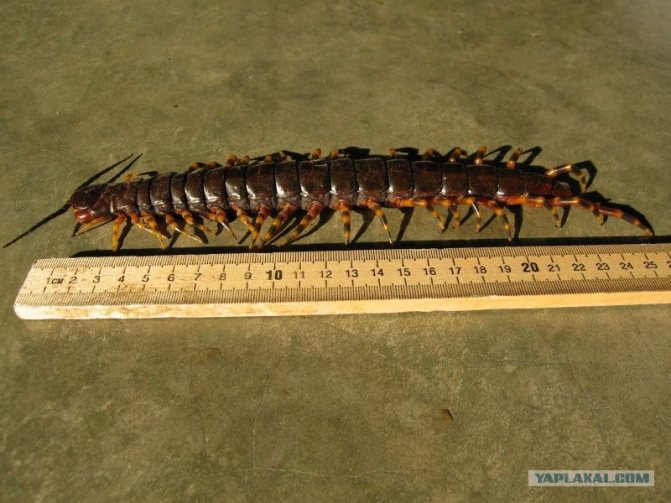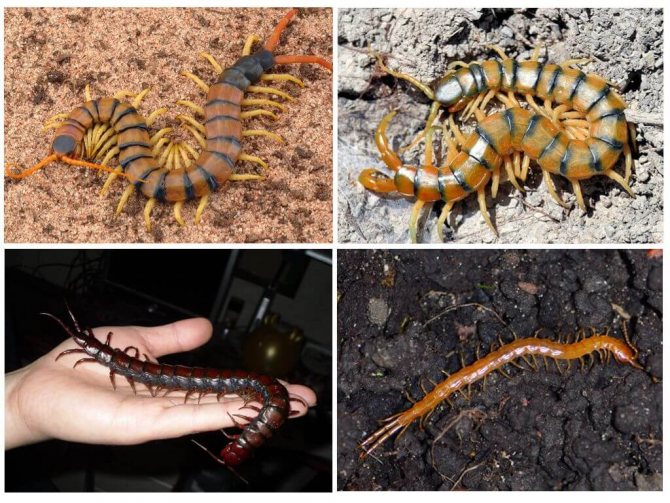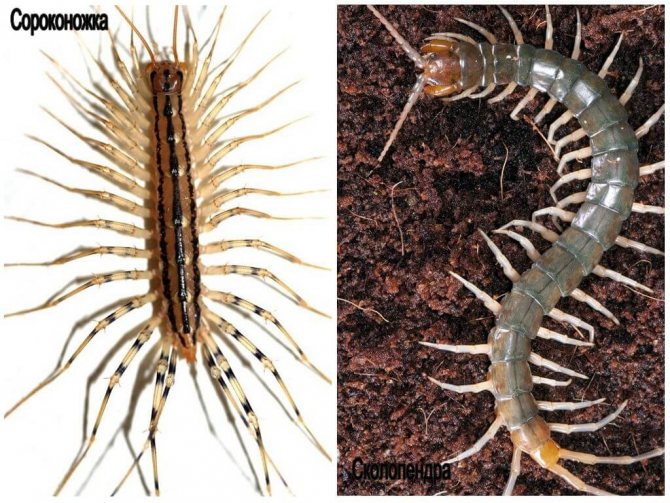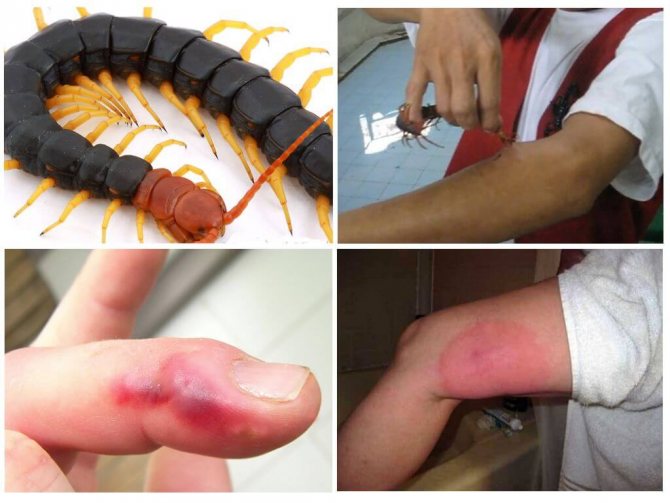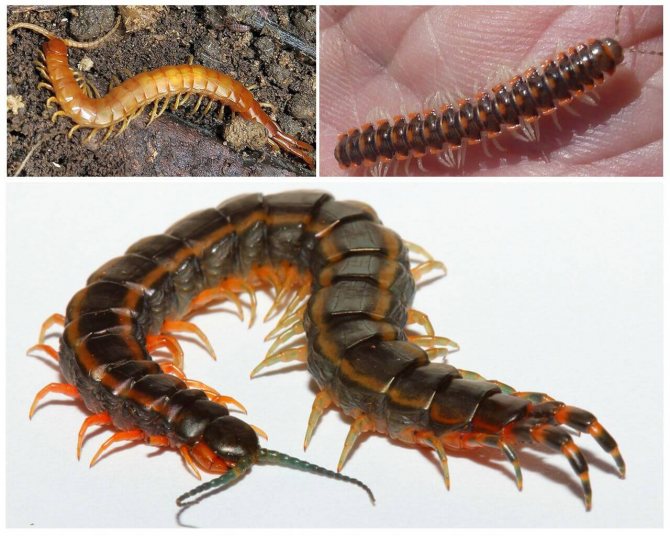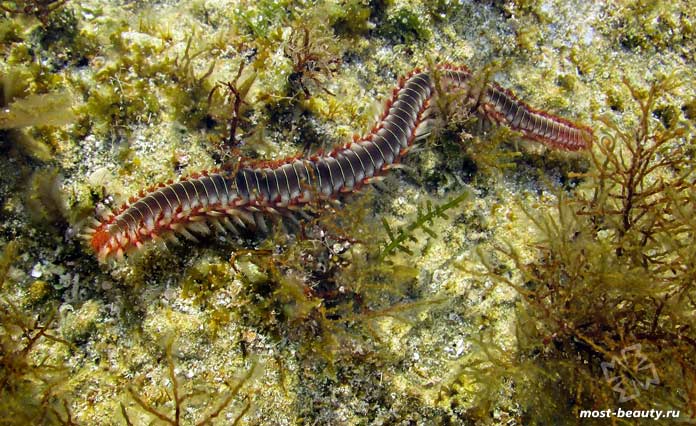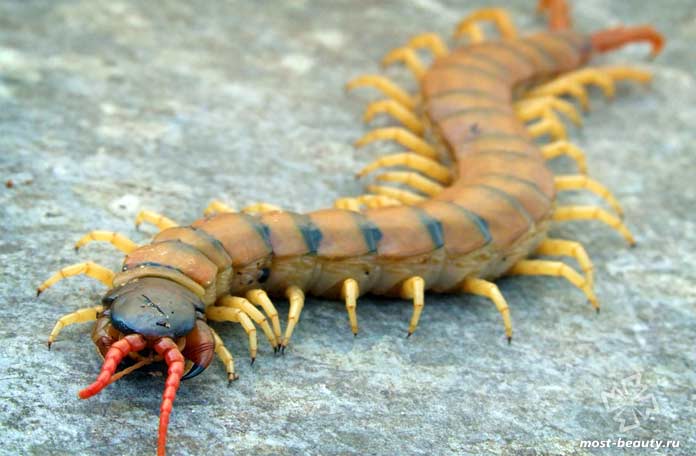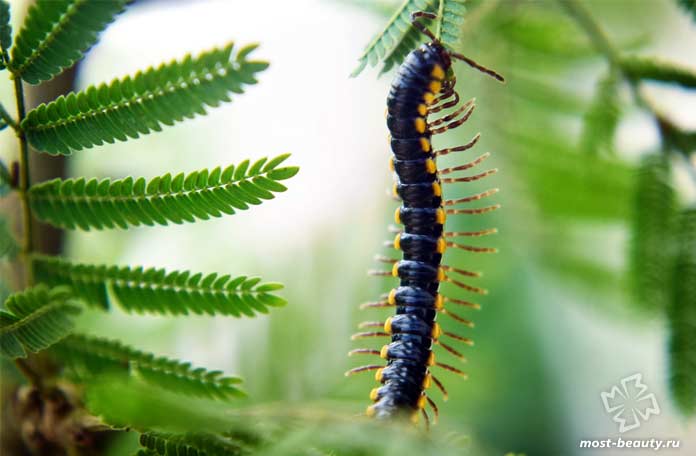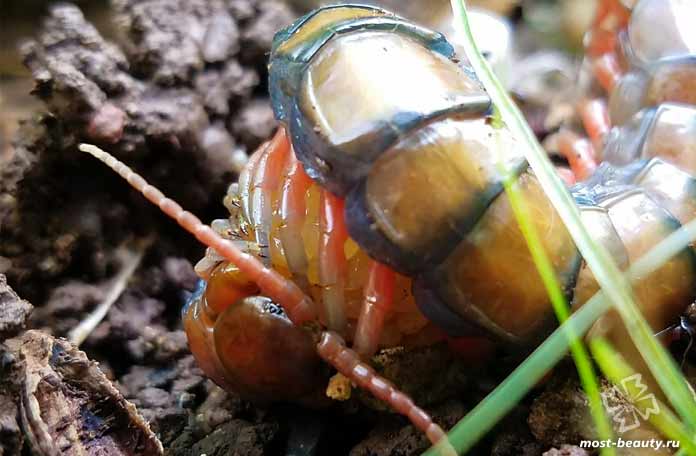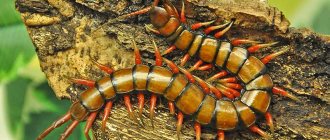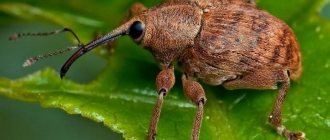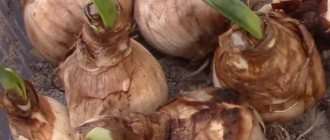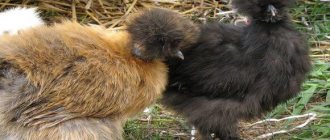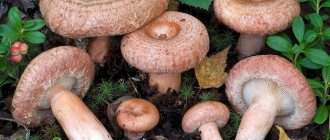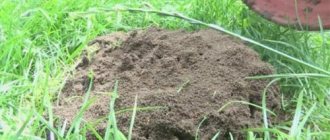general description
The giant scolopendra came to this planet, apparently, straight from a nightmare. This centipede reaches a quarter of a meter in length, and its body consists of 21-23 sections, each of which is equipped with a pair of quick dexterous legs 2.5 cm high. Scolopendra giant lives in South America, Puerto Rico and Jamaica.
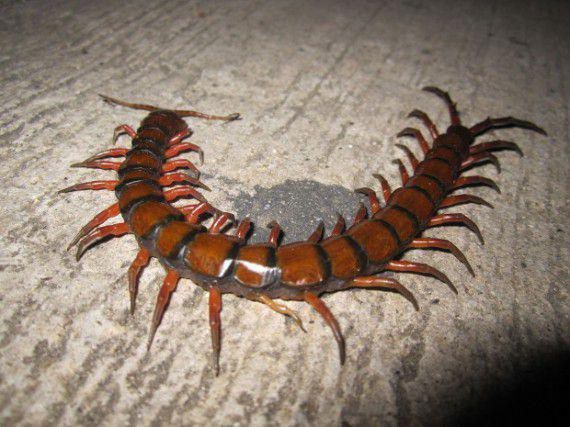
The centipede's head is equipped with strong jaws filled with venom - thanks to this, it is able to hunt animals that are much larger than it in size, for example, bats. In addition, the scolopendra is characterized by an irritable and nervous character, which is facilitated by the lack of vision - the eyes of the animal can only distinguish between light and darkness. This makes the scolopendra rather suspicious, and in response to a threat, she prefers to attack, injecting a paralytic poison into the victim.
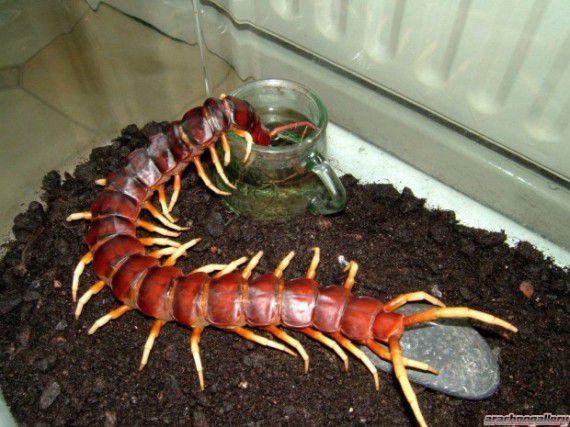

Being hungry, the centipede becomes very aggressive, it is able to develop high speed when hunting, and the agility and mobility of its body allows it to hunt even small birds. Scolopendra devours the victim gradually, since its digestive system is very primitive. For example, once researchers observed how she dines on a killed bat - in 3 hours she ate and digested about 35% of the victim's body.
The giant centipede is included in the list of the most dangerous animals. In addition, she has a repulsive appearance and has one unpleasant feature - she is not at all afraid of people. It is a cold-blooded predator that hunts not only small invertebrates and beetles, but also lizards, birds, mice and frogs.
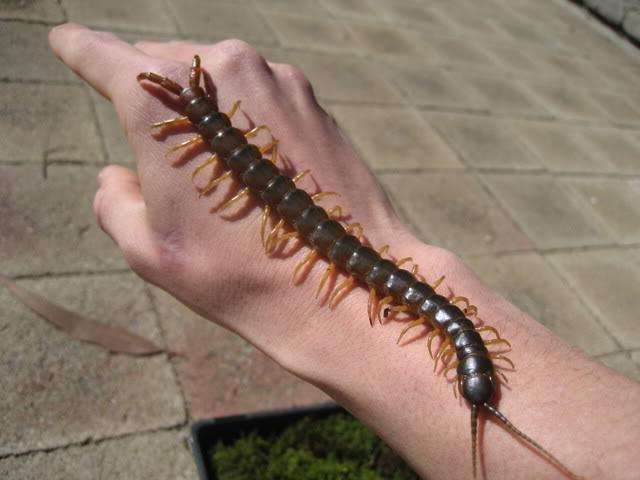

Poisonous apparatus
There are many poisonous centipedes in nature. The animal contains poison in the front jaws. It is with them that the centipede captures the victim, the released poison paralyzes and poisons the prey.
The centipede plunges its front pincers into the victim's body when attacking. After killing the victim, it begins to slowly chew, tidbits are sent down the throat. Scolopendra absorb food very slowly for a long time.
Scolopendra venom contains:
- bioactive compounds of acetylcholine;
- histamine;
- serotonin;
- lecithin.
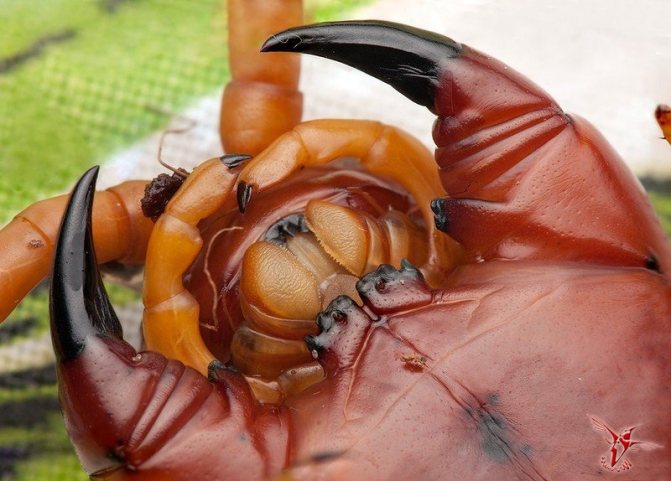

After the injection of poison at the site of the bite, puffiness forms. The body of the victim is paralyzed, which gives an excellent opportunity for the arthropod creature to feast on the caught bug. The most gigantic individuals can attack and eat big bats.
You can find out whether a centipede is poisonous or not by color. The more it approaches the natural color of the surrounding area, the more poisonous the individual is.
Usually the poison of scolopendra is no more dangerous to humans than the poisonous substances of a bee. Animals living in damp basements of residential buildings, as a rule, do not contain substances hazardous to humans. The animal needs poison to get food.
Scolopendra species
There are about 600 species of these predators in the world. They belong to the genus Labipod centipedes from the order Scolopendra. Bright representatives of these animals are the Californian scolopendra, ringed and Lucas scolopendra. The first reaches 20 centimeters in length and is found in the arid regions of Mexico and the United States. This species has one unpleasant feature - in a disturbed state, the animal causes inflammation of the human skin in the place of its contact with the limbs of this centipede.At rest, the Californian scolopendra is not dangerous.
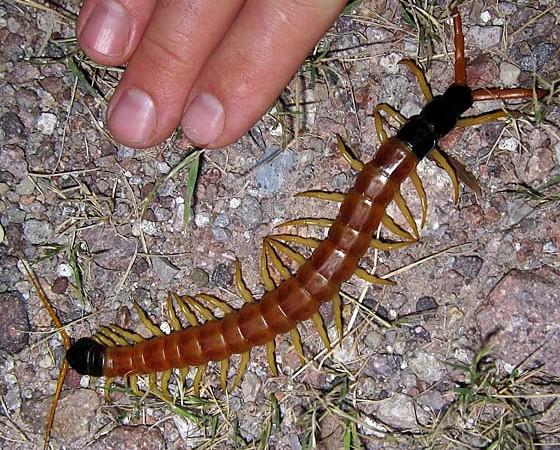

Ringed scolopendra is found in the Mediterranean basin, southern Europe, North Africa and southern Russia. It is widespread in the Crimea. The average body length is 14 centimeters, but some individuals reach 170 millimeters. This species has a beautiful golden yellow color. Like other members of the Scolopendridae family, the ringed scolopendra has venom glands.
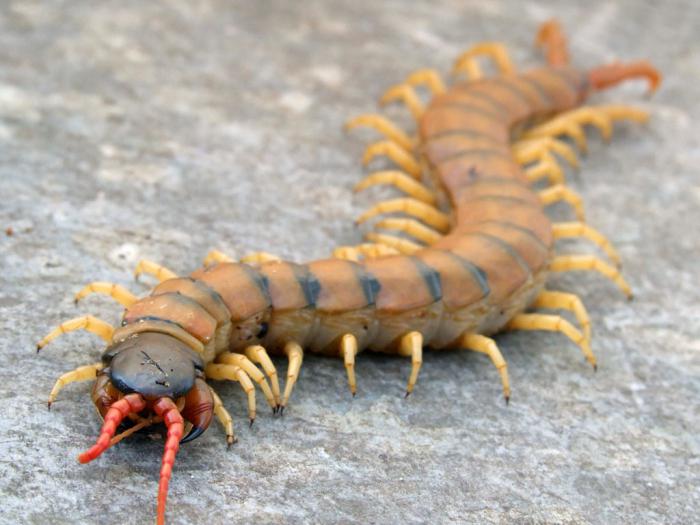

Outcome
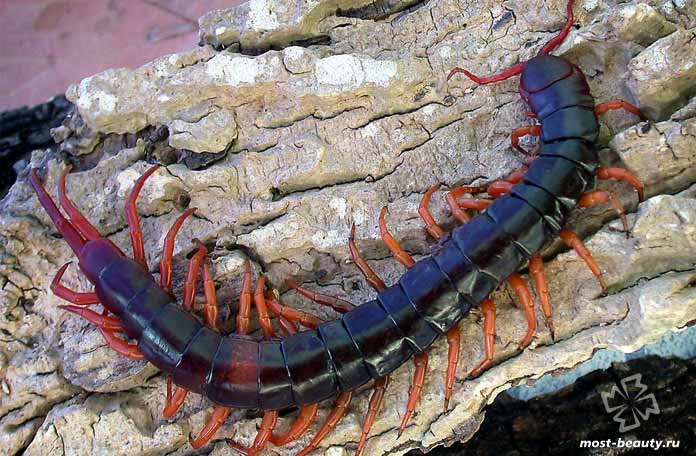

So we learned about these amazing arthropods, similar to huge worms with legs. There are people who apply scolopendra in the form of a tattoo on their body. And the interpretation is quite simple - such tattoos are applied by people with a rebellious character, contrary to generally accepted norms. The editors ask you to write in the comments about your attitude towards these animals. What scolopendra evoke a lot of emotions in you and have you met them in your life?
Lifestyle
Scolopendra giant, like all other representatives of the genus centipedes, is thermophilic and lives exclusively in countries with warm or tropical climates. This is a nocturnal predator that feels uncomfortable during the day in open spaces. All centipedes run very fast, but the giant one is particularly fast.
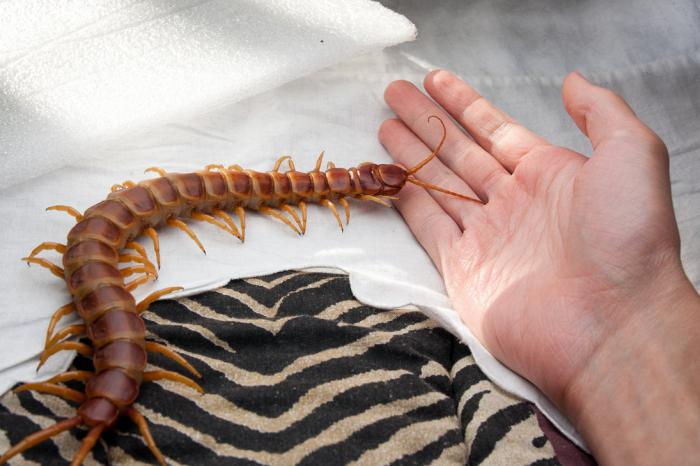

Scolopendra live mainly underground or in shelters, since their body does not have strong protection and quickly loses moisture.
She prefers to hunt small underground invertebrates: larvae, earthworms and beetles. Giant scolopendra can catch and kill small lizards, frogs, birds, mice and even small snakes. Catches a predator and bats. To do this, she climbs to the ceiling, where the victim sleeps, holds onto the surface with several claws, and attacks with her front legs, wrapping around the bat and injecting poison into it.
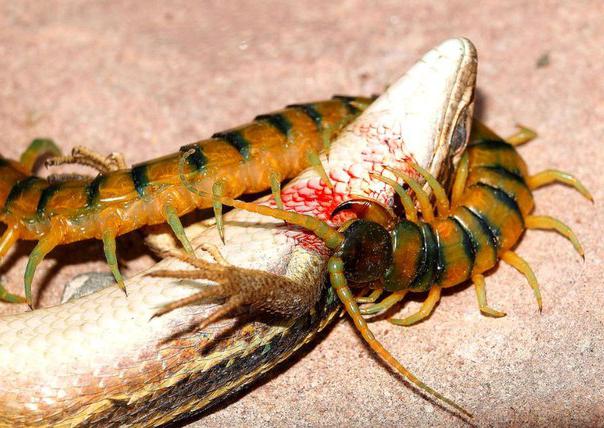

Scolopendra are bright individualists and prefer to live alone. However, the meeting of two males most often occurs quite peacefully. Cannibalism occurs in this type of millipede. Most often this occurs in captivity, when a hungry adult is able to eat young animals. In nature, this happens quite rarely.
Food
Nature has provided millipedes with anatomical devices for successful catching of victims - leg jaws, wide pharynx, poisonous glands, tenacious legs. Domestic arthropods are called flycatchers for their ability to immobilize insects, then eat for a long time.
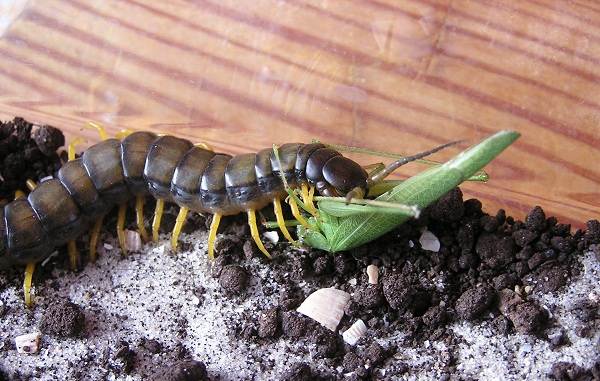

It is difficult to escape from a dexterous and agile predator. The ability to run on horizontal and vertical surfaces, to react quickly to any vibration gives her an advantage. Cockroaches, bugs, spiders become food.
The centipede is able to catch several victims at a time, hold them in its paws, and then eat them one at a time. It saturates slowly and for a long time. Scolopendra bite for most small creatures is fatal, butchering immobilized carcasses for an arthropod predator is not difficult.
Underground animals are of primary interest to forest centipedes. These are earthworms, larvae, beetles. When the hunters come out of hiding, they catch grasshoppers, caterpillars, crickets, ants, even wasps.
Developed sense of touch helps predators to provide themselves with food. A primitive digestive system requires constant feed processing. Hunger makes the centipede aggressive. Large species of tropical scolopendra feast on small rodents, snakes, lizards, attack chicks, bats.
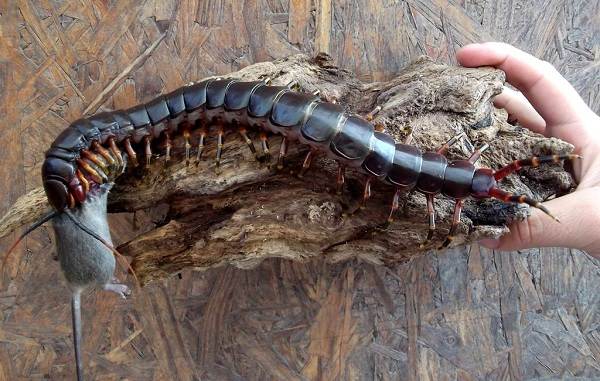

Those who like to breed scolopendra in terrariums need to know that different species cannot be planted in one container. Predators are cannibalistic - a strong individual will eat a weak centipede.
Amazing natural flexibility allows these creatures to crawl into the narrowest and most winding places to hide.Therefore, it is not a problem for her to escape from the terrarium. The content of arthropods has its own characteristics.
The soil should be moistened so that it is suitable for burrowing. You can add crustaceans wood lice to millipedes, their centipedes are not touched. Feeding arthropods should be close to natural - crickets, mealworms, cockroaches, insects. The temperature in the cage should be kept at approximately 27 ° C.
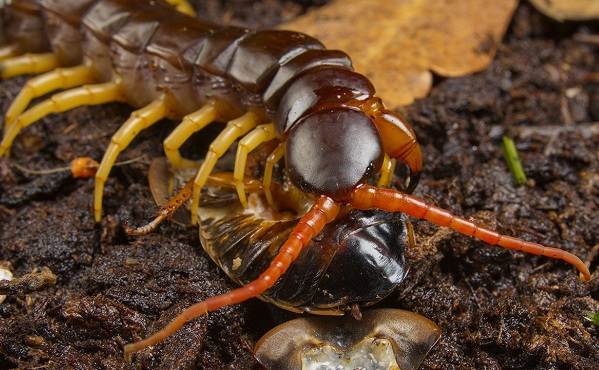

Anatomy
The body of the centipede consists of two parts: the head and the long body. It is divided into segments. Their number varies from 21 to 23. All of them are equipped with a pair of light yellow legs, which end in a pointed thorn. Their average length is 2.5 centimeters. Each of them has a poisonous gland. Therefore, when the legs of the scolopendra come into contact with human skin, inflammation occurs.
The head is a plate with eyes, two antennae and a pair of legs. In the course of evolution, the legs of the first segment of the body of the scolopendra turned into poisonous claws.
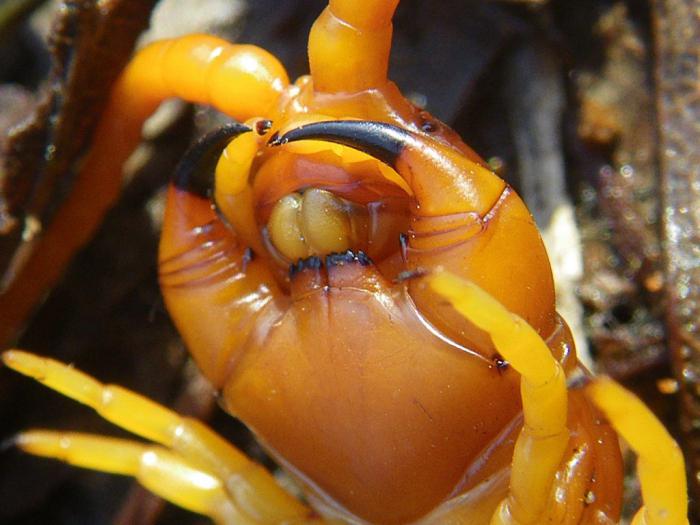

The last pair of legs also differs from the rest - they are larger in size and directed backward. The hind legs help the animal when moving along earthen holes and during hunting, acting as a kind of anchor.
Scolopendra giant has a beautiful copper-red or brown color. The color can range from yellowish to red, blue, green and purple. The color of an animal changes with age, and even in individuals of the same species, it can differ significantly.
The body of a predator consists of plates, which are interconnected by flexible membranes and protected by an exoskeleton. Giant scolopendra is a soft-bodied animal. The chitinous exoskeleton that does not grow, this centipede species, like many invertebrates, has to be shed from time to time. This process is called molting.
Bite actions
Immediately after the attack of the centipede, the bite site must be treated with alcohol. The drug neutralizes harmful toxic substances and acts as an antiseptic. If you have been bitten in nature while relaxing, the wound should be treated with a suitable agent at hand - cologne, perfume, vodka.
On top of the wound after disinfection, it is required to apply a sterile bandage with an antiseptic. We urgently need to get to the nearest hospital. If necessary, doctors will inject the necessary medications.
Maintenance and care
Giant scolopendra, the bite of which is extremely painful for humans, is often kept in captivity by lovers of centipedes. It is interesting to watch it, but it must be kept with care - it is a fast and aggressive animal. Inexperienced amateurs are better off abandoning such a dangerous "domestic" pet because of the very likely possibility of being bitten. Since scolopendra are flat and flexible, they can squeeze into a small gap and slip out of the terrarium. They live in captivity for a long time - up to 7 years.
It is necessary to maintain a relatively high humidity of the soil and air - animals are very sensitive to this indicator.
Scolopendra feed on cockroaches, flour beetle larvae and crickets in captivity. They eat slowly and infrequently. It is recommended to feed them 1-2 times a week.
Why can a centipede appear in a house or apartment?
If scolopendra appeared in a human dwelling (it does not matter - in a private house or apartment), then the conditions in it are better than in nature. The risk of centipedes in an apartment increases if in it:
- a large number of insects live;
- wet and damp (the main factor);
- heat;
- a lot of unlit space.
Usually the insect prefers closets, basements and bathrooms. Scolopendra can sink into a dwelling through the sewer, cracks in the walls, ventilation holes.
What threatens a meeting with a centipede
The danger of these predators is greatly exaggerated. All scolopendra have poisonous glands that produce poison, but many of them are harmless to humans, because they simply cannot bite through the skin.These are Cryptops, or blind centipedes, and drupes. A flycatcher living in houses can only bite in self-defense. Most often, they cannot bite through the skin of its jaw. But if this happened, the bite will be equal in strength to that of a bee.
What does a scolopendra bite look like? It depends on the type of millipede. When biting through the skin, the animal secretes poison, which causes burning, pain and swelling. The bite can also be accompanied by nausea and dizziness.
The venom of the giant centipede is especially toxic. It causes severe swelling (the arm may swell up to the shoulder) and fever. These symptoms persist for several days.
Video: Scolopendra catches and eats a bear
The only documented death from a scolopendra bite is the death of a child from the poison of Scolopendra subspinipes. This species has several names: Chinese, Vietnamese, or orange centipede.
Some species of these predators, when disturbed, secrete a protective fluid that, when in contact with the skin, causes burns. For example, the Californian scolopendra has such a feature.
After a millipede bite, you need to rinse the wound, apply cold and consult a doctor. Usually, drugs of the analgesic group are prescribed and tetanus prophylaxis is carried out.
The greatest danger is posed by female centipedes (they are more poisonous) for small children, people with weakened immunity and allergy sufferers.
Is an ordinary flycatcher dangerous for humans?
All scolopendra are poisonous insects, in which toxic substances are present not only in the jaws, but also in the claws and even just walking legs. Large tropical species are really dangerous to humans, but the Russian small common flycatcher is not dangerous, and the maximum that can happen after contact with it is reddening of the skin, and even if it is very sensitive. This is due to the fact that the amount of toxin in northern species is very small, and the poison threatens only the prey for which it is primarily intended. Thus, the local scolopendra, familiar to everyone, is useful, not dangerous, and while it lives in the house, you do not have to worry about pests appearing - it is a reliable guardian from them.
If we talk about topical millipedes, then they can be very poisonous. Some of them even pose a mortal threat to humans. Because of this, when starting an exotic insect as a pet, one must understand that it is also a very dangerous neighbor who is capable of inflicting a bite, which will require emergency medical assistance.
a brief description of
The Crimean ringed centipede is a large centipede of the genus chylopod of the labipod class. Covered with a dense chitinous shell (on soft soil, he is not afraid even of a blow with a stone). Large scales are arranged according to the principle of a tiled roof: the previous one partially covers the next one.
The length of an adult insect reaches 15-20 cm (the average individual is slightly longer than a lighter). The color of the carapace ranges from sandy to dark brown.
The head is flattened black with two swirling red whiskers, the legs are yellow (honey-colored). Each segment of the body has a pair of legs (most scolopendra have 21-23 pairs).
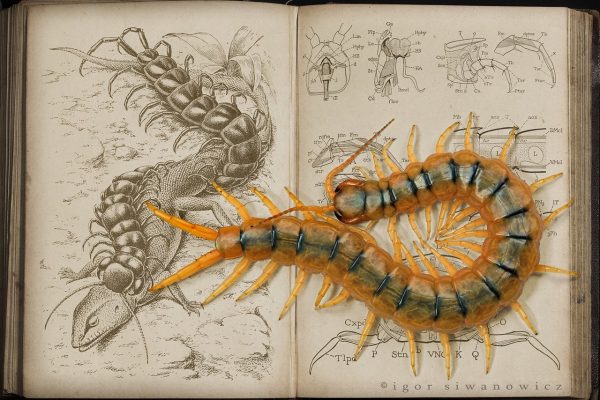

The first two legs are called leg jaws. The insect needs them to capture food and push it into the mouth opening, as well as to bite. The last two legs are longer than the rest, serve as a rudder or anchor, helping the centipede to maneuver on the ground.
Scolopendra bites, poisons and eats everyone it can defeat: spiders, cockroaches, grasshoppers. It hunts only in the dark. During the day it sits under stones, roots, heaps of foliage. Prefers moist, dark places.
Scolopendras also mate in the dark. The female lays about 120 eggs at a time, of which young animals appear after 2 months. The mother often eats the cubs.Life expectancy in captivity is about 6 years. How many millipedes live in natural conditions is not exactly established.
Toxicity
Each leg of the Crimean scolopendra consists of 6 segments, the latter are pointed and curved inward. They contain poisonous glands, the mouths of which open at the ends. When the victim bites, the centipede injects the main portion of the poison through the jaw.
Each section of the body also contains two venom glands, their ducts extending to the edges of the scutes. When the ringed scolopendra senses danger, it coils up, and a secret with a pronounced odor is poured out of the poisonous glands.


The main components of the venom of the Crimean scolopendra (DL50):
- acetylcholine;
- histamine;
- hyaluronidase;
- kininase;
- cholinesterase;
- serotonin;
- BAEE esterase.
Insects and arachnids bitten by a centipede quickly die. In small animals, mobility decreases, profuse salivation (salivation) is observed, pupillary constriction, muscle twitching, death is possible.
Control methods
You should not try to kill the centipede with a slipper or other means at hand. This is almost impossible to achieve due to the fact that her body is covered with a very dense shell. In addition, the dodge of the insect should be taken into account, which greatly interferes with making an aimed strike. It is preferable to catch the centipede with a scoop, brush and rubber gloves. Then take it out as far from home as possible.
Chemicals
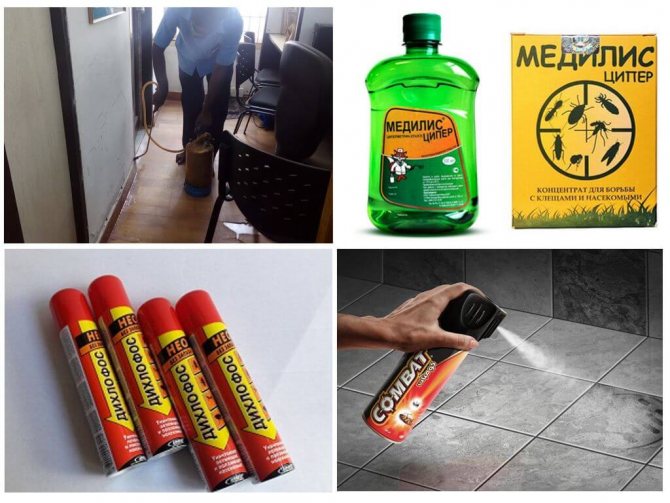

Destruction of harmful insects
You can remove scolopendra in the house using chemicals. For the fight, drugs of a wide spectrum of action are used, designed to destroy various harmful insects. These include:
- Dichlorvos;
- Medilis tsiper;
- Henkel Combat;
- Raid;
- Starex.
When using these insecticidal preparations, personal protective equipment is required: a respirator, rubber gloves and the most closed clothing.
Folk remedies
However, it is not always possible to use chemical agents to combat scolopendra in the house. Therefore, many people resort to more gentle methods of struggle, using time-tested folk recipes. Some sources recommend using boric acid for this purpose, which is used against many domestic insects.
However, one should not forget that scolopendra is a predator, and it is unlikely that baits with boron powder will attract her attention.
Traps
Another method to get rid of scolopendra in the house. All you need to do is place sticky traps where centipedes appear. The result of their struggle will be obvious very soon.
Specialized services
With a large number of centipedes, it is preferable to contact a specialized service, whose employees use professional means to solve this problem.
Reproduction
By their habits, giant centipedes are individualists. Fights between them are rare, however, when sorting out the relationship, they cling tightly to each other and are in this position until the death of one of the rivals.
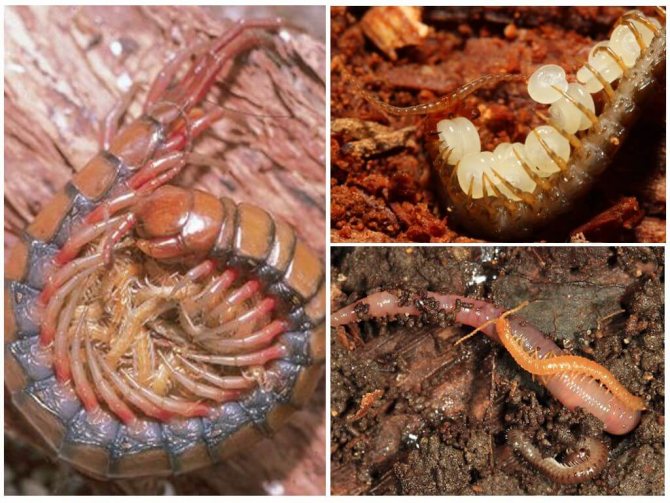

Reproduction of scolopendra Females reach sexual maturity by 2.5-3.5 years. Reproduction takes place in the spring, and, thanks to the presence of parthenogenesis, they can fertilize eggs on their own. During childbirth and later, females secrete a special secret that prevents mold from appearing on the laid eggs, and also helps to maintain the necessary moisture. After a few weeks, small protonymphs appear, similar to worms, they grow quickly: after 5-6 weeks, the color begins to appear, then after 10-14 days the first molt passes.
Interesting!
The life cycle of huge centipedes allows them to be attributed to long-livers, because in captivity, some specimens live up to 7 years.
Preventive measures
Nobody canceled preventive measures in the fight against "uninvited guests". Be on guard for your own home and follow some safety rules.
What are they:
- if these arthropods are found in the dwelling, you should not walk around the house without indoor slippers;
- check pajamas and bedding for centipedes before bed, as these creatures activate at night;
- since scolopendra do not settle in houses in large colonies, throwing only 1-2 representatives out into the street or placing in an airtight container, you can already sleep peacefully;
- connect a pet, such as a cat, to the elimination of the "tenants", as it can perfectly cope with this task;
- thoroughly ventilate and dry a damp room, and then a predatory arthropod will bypass your house on the tenth road;
- do not allow water to accumulate in the sink and bathroom;
- Before building a new home, carefully consider the ventilation system so that condensation does not accumulate in the rooms.
Now you know many of the subtleties and secrets of a successful arthropod extermination operation. We sincerely hope that this information was useful to you. Having received the necessary knowledge in theory, you can easily proceed to the practical part.

